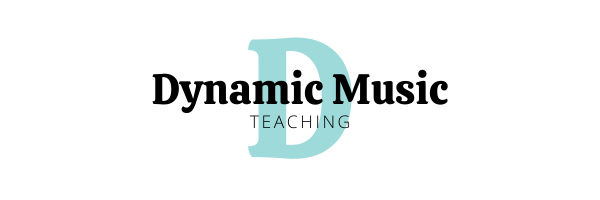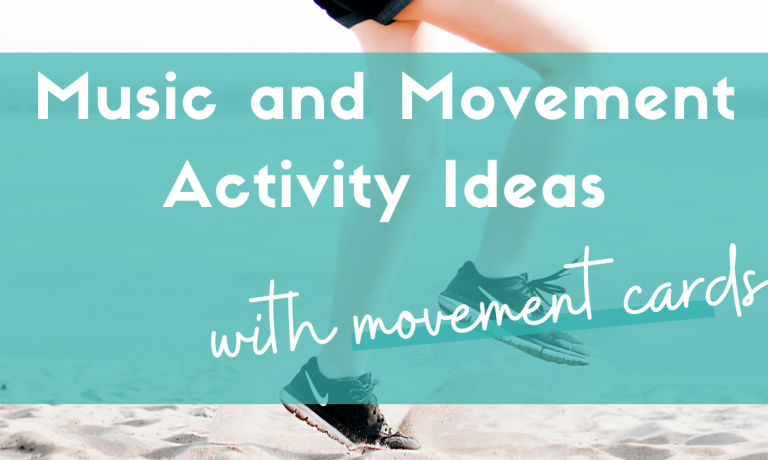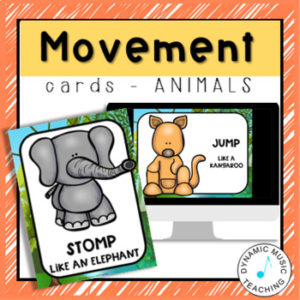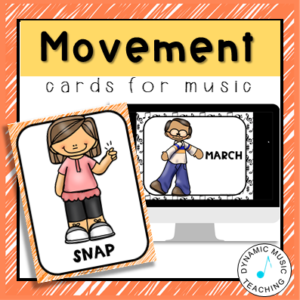Looking for activities for music and movement? There are lots of ways to get students moving to music, but one of the simplest ways to add music and movement for kids into your classroom (or your home!) is with cards for movement.
What are movement cards?
Movement cards, sometimes also called brain break cards, have actions (such as stomp, tap your knee, or lumber like a bear) written on them along with images. They are a popular way to get kids in elementary and even preschool up and moving. Movement cards can be used in any subject, or even at home, but they are especially fun to pull out in music class!
Keep reading for 7 ways to use them in music and movement activities for elementary students. For music and movement activity for preschool ideas check out this post instead.
Can I make my own music and movement activity cards?
Yes, you can easily make your own set of movement cards! It can be as simple as writing actions on individual cards or slides. Or, if you feel a bit fancier, type them up and add some fun clip art! If you’d prefer a done-for-you version for a quick win, you can check out the movement cards in my shop here. They all include printable cards plus a slide show version.
If you’d like a movement cards free printable, check out my free weather theme set here.
Music and movement activity ideas
Freeze dance game
We’ve all played freeze dance at some point. It’s the classic kids’ party game, where you move or dance while the music is playing, and must freeze when it goes off to avoid being ‘out’. To play freeze dance with movement cards, show one card each time you turn the music on, and change cards when the music goes off.
Try using a freeze dance game to experiment with different styles of music and broaden your students’ musical horizons in a fun and non-threatening way.
Movement card freeze dance is a perfect reward for the end of class, an activity to leave for a non-music sub, or a way to introduce a new style of music your students will be learning about.
Steady beat practice
Steady beat activities are perfect for kindergarten and first-grade music. Play music with a strong beat and practice clapping the beat together. Once you have introduced the steady beat, hold up a card, and encourage the kids to do the action on the card (for example, tap your knees) to the beat of the music.
For older grades, they might enjoy figuring out how to do more creative movements in time with the steady beat (for example, floating like a jellyfish). With older students, you may also wish to rotate through the movement cards more quickly. For example every 8 or even 4 beats to keep them on their toes. You’ll be surprised how much fun your students have with this!
Scarf and ribbon movement cards
Do your students love when you pull out scarves? Try bringing out scarves or ribbons while using movement cards, or look for/make scarf movement cards with scarf and ribbon movements on them. Encourage your students to move to the sound of the music. Is it fast and high? Do the scarf movement fast and high.
No-fuss choreography for music classes
Movement cards with dance movements are a great way to bring creative dancing into your music class without fussing over choreography.
Creative movement to a playlist
Try making a playlist of music (1 song for each movement card). For example, if you are using 10 animal movement cards, make a playlist of 10 different song with one to suit each animal. Slow and heavy for the bear, beautiful and flowing for a jellyfish etc.
For a fun twist, put one song in that does not suit the animal at all, and have the students freeze or call out when they hear it.
Transitions, or moving between activities
Choose a movement card while your class is moving between activities or areas of the music room.
If you walk your students to the classroom, movement cards are also a fun way to walk in line. Choose, or let the line leader choose, a movement card with a quiet action and have the students all do the movement (for example, sneak like a cat) while walking in line.
Guessing game
To play this game, put on a piece of music and show two or three movement cards. Have your students do the movement (one of the cards you have shown) that they feel best represents the music.
To introduce this movement game you might prompt your students to listen for: is the music fast/slow, loud/soft, graceful, and so on.
This is another fun way to introduce something new to your students! Play a different style of music or a song you will be teaching in a future class.
This guessing game will work best with themed movement cards (such as animals, weather, etc.) rather than body percussion movements (such as clap, stomp, etc.).
What music and movement activity will you try first?
I hope these ideas are helpful for you. Please share below if you have another music and movement activity to add to the list!







